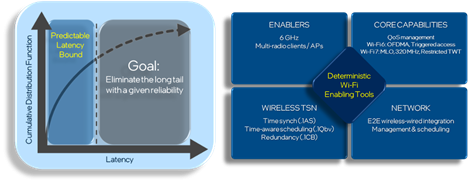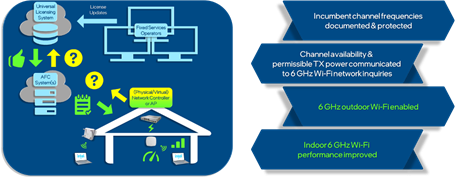Even with its status as the most ubiquitous wireless networking technology for both consumers and businesses alike, Wi-Fi continues to grow and evolve as a technology. Over a billion Wi-Fi access points connect close to hundred billion of IoT devices, smart phones, tablets, laptops, desktops, smart TVs, video cameras, monitors, printers, and other consumer devices to the Internet to enable millions of applications to reach everyone, everywhere. [Pahlavan, K., Krishnamurthy, P. Evolution and Impact of Wi-Fi Technology and Applications: A Historical Perspective. Int J Wireless Inf Networks 28, 3–19 (2021). https://doi.org/10.1007/s10776-020-00501-8]
The evolution of Wi-Fi technology also resulted in the successful commercial use of advanced capabilities like spread spectrum, OFDM, LDPC, MIMO and mmWave, which then became more broadly adopted by the cellular phone and wireless sensor networking industries.
The current standard-bearers, Wi-Fi 6 and Wi-Fi 6E (i.e., Wi-Fi 6 extended to the 6 GHz band), are here today. Use cases for advanced Wi-Fi 6 and 6E continue to expand and diversify, with growing applications such as gaming, wearables, use in automobiles, AR/VR applications for consumers, but also Industry 4.0 applications for robotics, smart manufacturing, and Autonomous Guided Vehicles (AGVs).
So where does Wi-Fi go from here? Does it simply continue to develop faster speeds and higher performance? The answer is yes, but equally important, Wi-Fi will continue to add new capabilities to enable deterministic wireless operation. In this context, deterministic wireless communication is the ability of Wi-Fi to guarantee that data will be transmitted in a specified, predictable period of time. Rather than pure speed, this is about data delivery with a given reliability, although all these attributes may be required for a specific application. The ability to deliver deterministic wireless performance at low cost is a key characteristic that separates Wi-Fi from other wireless technologies.
One of the key enablers to Wi-Fi evolving to support deterministic wireless has been the FCC’s decision to open the 6 GHz spectrum band for unlicensed use. This is the first new major unlicensed spectrum allocation below 60 GHz in nearly 20 years. It is hard to imagine Wi-Fi 7 and beyond without this new spectrum availability. What’s more, Wi-Fi’s use of 6 GHz is exclusive to Wi-Fi 6 and above devices. With no legacy Wi-Fi device interference or overhead, users can experience greatly improved wireless network performance. Add to this the many wide channels (160/320 MHz) that help deliver much faster speeds as well.
Deterministic Wi-Fi with Wi-Fi 7
Achieving the ability to provide deterministic wireless performance is a major goal of Wi-Fi 7, as will probably be the case in future versions of Wi-Fi. Wi-Fi 7 will build on the IEEE 802.11be standard amendment, which in turn builds on the 802.11ax (the basis for Wi-Fi 6/6E). Wi-Fi 7 will be about 3.6x faster than Wi-Fi 6/6E, with an aggregate throughput that can reach close to 35 Gbps. As with Wi-Fi 6/6E, Wi-Fi 7 will operate in the 2.4 GHz, 5 GHz, and 6 GHz frequency bands.
Key enhancements include doubling the PHY layer channel size to 320 MHz, increasing the modulation order from 1024-QAM to 4096-QAM, and introducing a puncturing capability that will enable Wi-Fi 7 to better coexist with other wireless technologies using the same spectrum and improve spectrum efficiency.
The MAC layer will include features such as multi-link operation, enhanced Quality of Service (QoS) and low latency support, as well as a triggered P2P transmission scheme. All of these new capabilities build on existing Wi-Fi to deliver better, more deterministic performance and taking a major step forward in terms of improvements to worst-case latency & jitter.
As demand for deterministic wireless applications grows, there is an increasing number of technologies and tools that, together with Wi-Fi 7, will enable delivery of deterministic performance. The graph in Fig. 1 depicts some of the technologies and tools that will be leveraged to deliver deterministic Wi-Fi operation (particularly in managed environments). Many such capabilities are available today .

In particular, we expect low power indoor operation in the newly available 6 GHz frequency band to be one of the key means that will enable Wi-Fi 7 to reach its deterministic operation goal. On top of that, for countries that support this mode of operation, Automated Frequency Coordination (AFC) will enable clients and standard power Wi-Fi access points (APs) to use higher transmitting power (e.g., 6dB more) in allowed frequencies, while protecting incumbent services from harmful interference. That extra power boost will go a long way to further improving connectivity performance and coverage range of Wi-Fi networks, both indoors and outdoors.
With AFC, Wi-Fi 7 will be able to better serve an expansive set of outdoor applications including transportation and logistics such as in tarmacs, large-scale agricultural applications, rural broadband applications, municipal outdoor applications, stadiums, and large outdoor campus environments.

As shown in Fig. 2, AFC works by enabling standard power APs (or network controllers) to request a list of available channels from an associated AFC System. These channel availability requests include information such as AP geolocation (with uncertainty estimate), Regulatory-ID, and AP serial number. The AFC System then returns a list of available channels and permissible operating powers, which the AP or network controller can then choose from to deliver local connectivity.
This is just one of multiple Wi-Fi innovations that are expected to be developed between now and the time Wi-Fi 7 systems will hit the market. Despite some of the marketing rumblings that you may have read about, Wi-Fi 7 technologies are still a few years from seeing large-scale deployments. Wi-Fi 6/6E is here today and enables a host of new applications all on their own. Much as we see some speculation around 6G services, even though 5G is just hitting its stride, there is also a gap between Wi-Fi 6 and Wi-Fi 7.
That said, these developments are extremely exciting and point to a bright future for this most ubiquitous of wireless networks. Wi-Fi 7’s powerful combination of new capabilities, higher throughput, promise of deterministic and predictable Wi-Fi performance, and improved reliability and QoS is set to power a whole new generation of consumer, enterprise, gaming, IoT, wireless XR and Industry 4.0 applications.

This article was written by Carlos Cordeiro.